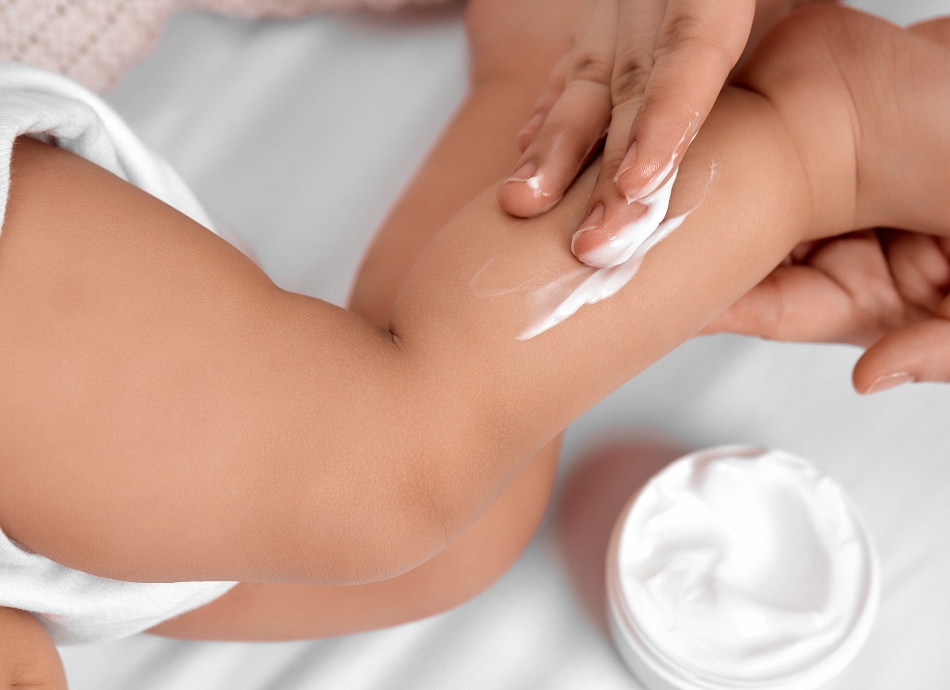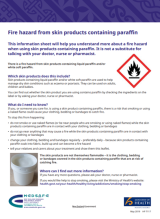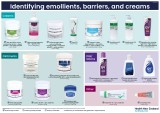Emollients and moisturisers
Key points about emollients and moisturisers
- Emollients and moisturisers hydrate your skin (keep moisture in your skin).
- They can be applied generously and regularly to support your skin's natural barrier.
- Find out about the different types and which is best for you.

Emollients and moisturisers hydrate (keep moisture in) your skin. They do this either by drawing water from the deeper skin layer to the surface, which keeps the skin moist, or by creating a layer on the skin's surface, which prevents water from escaping.
- Emollients and moisturisers are available as creams, ointments or lotions and are designed to treat dry skin, eczema and dermatitis.
- While the names may be used to mean the same thing, emollients are designed to soften skin and moisturisers add moisture.
- Applying emollients and moisturisers generously and regularly can help lower flare ups of eczema by supporting your skin’s natural barrier.
- For dry skin conditions, apply an emollient or moisturiser at least 2 times a day.
- For moderate or severe dermatitis or eczema, you may also need other treatments such as steroid cream and ointments.
- If an emollient and a steroid cream or ointment are prescribed at the same time, apply the emollient 15 to 30 minutes before the steroid.
- Always check the expiry date of your emollient. If it's expired, the product may have separated or decomposed and there is a greater risk of contamination with bacteria.
Types of emollients
There are 3 types or methods of application of emollients:
- Leave-on emollients are left on your skin once applied.
- Soap substitutes are used instead of soap and must be washed off your skin a few minutes after application.
- Bath additives are also called bath emollients. They're added to bath water and are thought to leave a film of oil over the skin.
Leave-on emollients are left on your skin once applied. There are a variety, ranging from less greasy to very greasy. The choice of emollient depends on how dry your skin is and your preference.
Check for the ingredient sodium lauryl sulphate (SLS)Some brands of emollient may contain an ingredient called sodium lauryl sulphate (SLS). If it does then it can be used instead of soap but must be rinsed off after use. DO NOT use it as a leave-on emollient as it can irritate your skin. |
Emollient products may also need to be changed depending on the season. For example, if you have drier skin during winter you may benefit from using a more greasy emollient over this time.
Types of leave-on emollients
Light, non-greasy lotion
- These are also called mineral oil lotions. Examples include Alpha-Keri Lotion® and DP Lotion®.
- These products contain lanolin and may cause irritation in some people. This is more common in people who have atopic eczema.
Slightly greasy cream
- Examples include cetomacrogol cream also called non-ionic cream. Read more about cetomacrogol cream.
Moderately greasy cream
- Examples include sorbolene with glycerin or glycerol cream, urea cream and fatty cream.
- Don't apply urea-containing cream to cracked, broken or oozing skin.
Very greasy ointment
- Examples include petroleum jelly (Vaseline®), Duoleum® and emulsifying ointment (SLS-free brands).
- These are preferred for very dry or thickened skin.
How to use leave-on emollients
- Apply generous amounts to the affected areas at least twice a day, or more often if possible. Using it several times a day is beneficial, especially when your skin is very dry and cracked.
- They may be used all over your body, including your face.
- Using emollients soon after a bath or shower can make them more effective. Gently pat your skin dry with a towel and apply the emollient.
- Emollients are best applied by dotting the product onto your skin and then spreading it using a downward stroking motion in the direction of hair growth to avoid blocking hair follicles. It's not necessary to rub the product until it's all absorbed.
- If your cream is in a pot, use a spatula or spoon to get the cream out (to keep the cream clean). Some people put the cream in a pump bottle to reduce contamination.
- The quantity of emollient you'll use will depend on the size of the area you’re applying it to, the condition of your skin, and whether you’re also using the emollient as a soap substitute.
- As a general guide, to treat your whole body the recommended quantities used are 600 grams per week for an adult and 250 to 500 grams per week for a child.
- If you’re using a pot of emollient and have had a skin infection, throw away the rest of the emollient and start a new pot once your infection is healed.
Soap substitutes are used instead of soap and are washed off your skin a few minutes after application. These are also called wash-off emollients.
Regular soap can be irritating to dry, inflamed or sensitive skin so soap substitutes are a good alternative. Two common soap substitutes are aqueous cream and emulsifying ointment.
- Some soap substitutes contain an ingredient called sodium lauryl sulphate (SLS). If it does, then the product can be used instead of soap but must be rinsed off after use. DO NOT use it as a leave-on emollient or moisturiser as it can irritate your skin.
- Soap substitutes should be gently rubbed onto your skin before rinsing off completely. You can also add them to bath water and soak in the bath for 10 to 20 minutes, then rinse them off.
- Slip hazard: Take care when using soap substitutes – these can make the floor or surface slippery and increase your risk of falling over. If you're using them for a baby, take care when you're holding the baby in the bath.
- Read more about aqueous cream and emulsifying ointment.
Bath additives (also called bath emollients) are bath oils or emulsifiers that are added to the bath water. They're thought to leave a film of oil over your skin.
When used for childhood eczema, a 2018 study found that bath additives are probably not effective and unlikely to lead to improvement in eczema. The authors advise to stop using bath emollients but to keep using leave-on emollients and soap substitutes. Read more about the childhood eczema study(external link).
Emollients are available in different forms such as lotions, cream and ointments.
- Lotions have a higher water content than creams or ointment, and can evaporate faster. They need to be applied more often. They may not be suitable for eczema, where the skin needs to be kept hydrated at all times.
- Creams are better than lotions because they retain moisture for longer. They are preferred to ointments because they're absorbed faster into the skin. Some creams have additives such as glycerol and urea that attract and hold water. Creams are preferred to ointments if your skin is weeping or oozing.
- Ointments form a covering layer that prevents evaporation of water from the skin. Ointments are greasier and thicker and may be less cosmetically acceptable, but are better at preventing evaporation. They're more difficult to wash off, except emulsifying ointment, which can be used as a soap substitute. Ointments may be more suitable than creams for people with more severe symptoms, such as dry, scaly areas of skin. They're not suitable if your skin is weeping or oozing.
The best emollient is one that’s used regularly so it’s important to find one that suits you. This will depend on the dryness of your skin, the area of skin involved and what is comfortable and acceptable to you.
- You may need different emollients for different parts of your body, and some areas of skin may need treatment with different emollients during flare-ups. For example, creams can help to ease inflammation, as the evaporation of water cools the skin, whereas greasy ointments are more suitable for dry skin.
- More than 1 emollient may be required for use at different times of the day, and emollient products may also need to be changed depending on the season. For example, if you have drier skin during winter, you may benefit from using a more greasy emollient over this time.
- Try different products until you find one you like and will use throughout the day.
- If an emollient irritates your skin, try a different product. In very young children, watch for signs of discomfort or increased skin irritation when using a new emollient.
If you're using emollients containing paraffin, take care because emollients can soak into clothing and bedding and the paraffin oils make these items catch fire more easily. This is especially important if you’re applying large amounts over large areas.
If you're using an emollient, check the ingredients on the label or ask your healthcare provider whether it has paraffin in it. Paraffin is also called liquid paraffin or white soft paraffin.
Here are some tips to lower the risk:
- Keep away from open fires and flames (eg, candles) and don't smoke (or be near people who are smoking) when you're using emollients containing paraffin.
- Change clothing, bedding and medical dressings regularly, preferably daily, because paraffin-based emollients soak into fabric, build up and can become a fire hazard.
- People most at risk of burns are older adults who smoke. It's even higher risk if you're using home oxygen.
Read more about the fire hazard for skin products containing paraffin(external link).
Emollients and moisturisers (external link) Dermnet NZ
Emollients and eczema creams(external link) Patient Info, UK
Brochures
Fire hazard from skin products containing paraffin(external link) Medsafe, NZ, 2019
Identifying emollients, barriers, and creams [JPG, 1.5 MB](external link) Health NZ | Te Whatu Ora, 2025
Medicines and side effects(external link) Healthify He Puna Waiora, NZ, 2024
5 questions to ask about your medications (external link)Health Quality and Safety Commission, NZ, 2019 English(external link), te reo Māori(external link)
For healthcare providers
A sticky choice – choosing emollients for eczema in children(external link) BMJ visual summary, UK, 2019
References
- Emollient and barrier preparations(external link) New Zealand Formulary
- Emollients(external link) New Zealand Formulary for children
- Childhood eczema – improving adherence to treatment basics(external link) BPAC, NZ, 2021
- Emollient bath additives for the treatment of childhood eczema (BATHE) – multicentre pragmatic parallel group randomised controlled trial of clinical and cost effectiveness(external link) BMJ 2018;361:k1332
- Bath emollient additives probably not effective for childhood eczema(external link) Goodfellow Gems, NZ, 2019
- Prescriber Update June 2019(external link) Medsafe, NZ, 2019
- Treating childhood eczema – a topical solution for a topical problem(external link) BPAC, NZ, 2015
Brochures

Fire hazard from skin products containing paraffin
Medsafe, NZ, 2019

Identifying emollients, barriers, and creams
Health NZ | Te Whatu Ora, NZ, 2025

Health Quality and Safety Commission, NZ, 2019 English, te reo Māori
Credits: Healthify editorial team. Healthify is brought to you by Health Navigator Charitable Trust.
Reviewed by: Stephanie Yee, Pharmacist, Auckland.
Last reviewed:
Page last updated:





